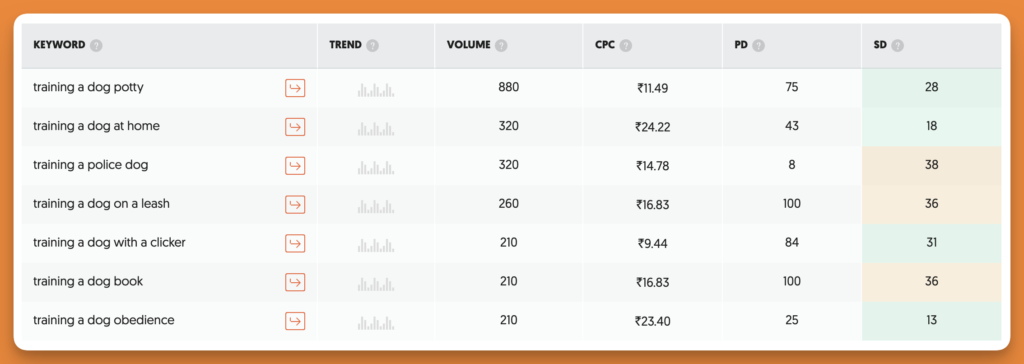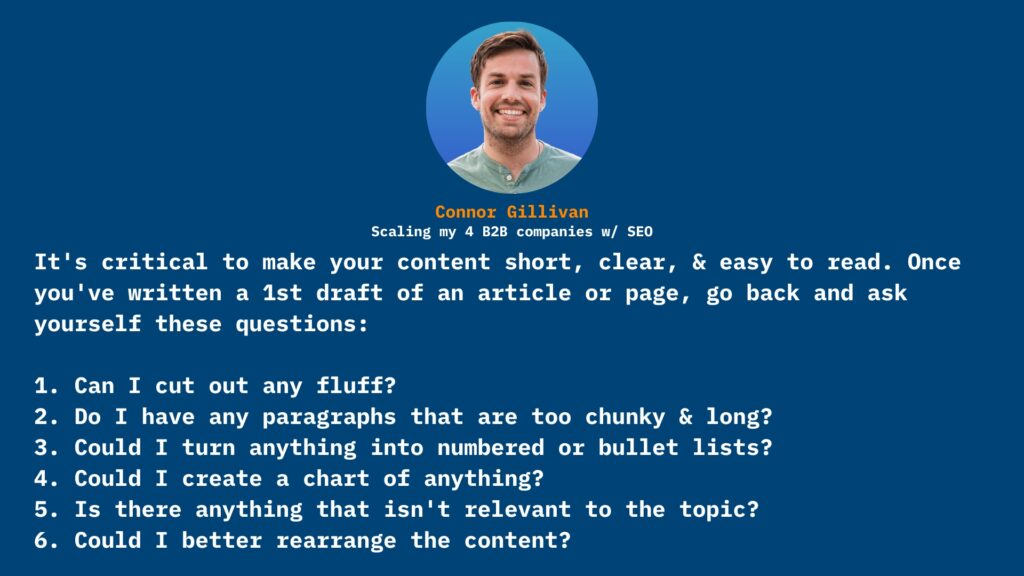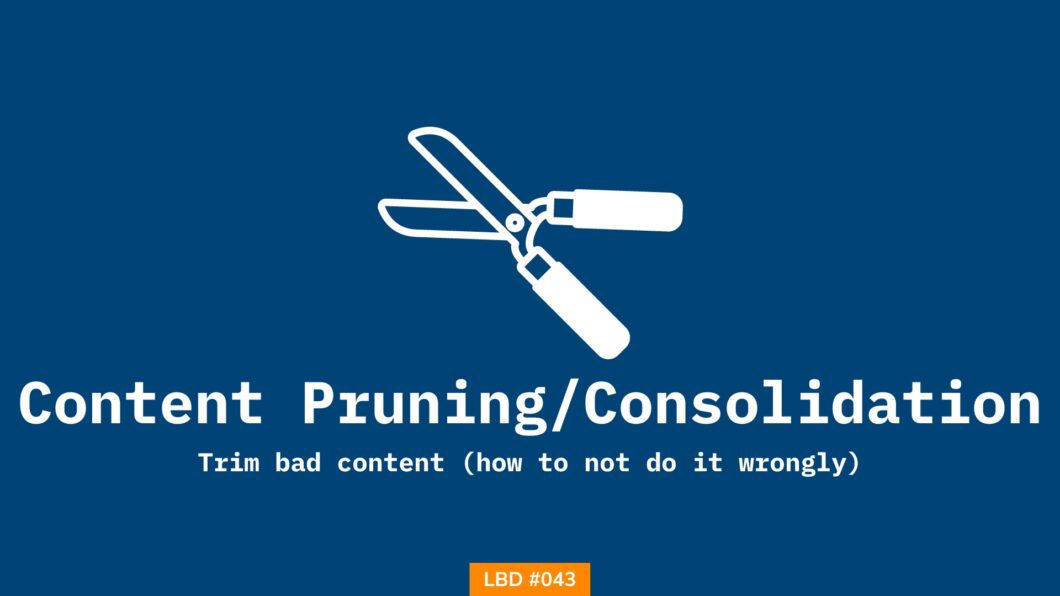Reading time: 4 minutes
Table of Contents
TL;DR & Summary
Ranking for more keywords is a solution and a problem, at the same time.
But ranking for more keywords brings the poor quality of traffic.
Improving the quality of traffic requires deleting or consolidating unwanted or poor-quality pages.
But what if the page you’re about to delete or consolidate, explodes and gets you a ton of traffic?
Let’s understand content pruning.
By the end of this issue, you will be able to:
- Trim bad content
- Eliminate internal conflicts of content
- What is content pruning & how to do it properly
If your content isn’t created logically, you can invite internal conflicts between pages. Search engines can’t decide which page is more relevant for a particular query, none of the pages are going to rank.
The internal traffic is causing more harm than good.
Imagine working hours on a post assuming it would go bonkers & you’d get a ton of organic traffic. Only to figure out that the post you just published is internally conflicting. Neither the post you publish is ranking, nor the post it’s conflicting is.
Understanding the difference between keywords & semantics
If you’ve been blogging for a while now, you’d know what semantic keywords are. When you optimize a page for semantic keywords, you’re most likely to accidentally create internal tension. John Mueller in an AMA session on Reddit addressed this issue.
He showed his preference for having fewer but stronger pages. Keywords are hints related to the topic of the post you’re publishing. Furthermore, semantics are the deeper elements of the topic. Semantic keywords usually don’t have context.
Let me make this very clear, there is no formal penalty for having duplicate content, but obviously, there’s a catch. What is considered duplicate content, you’d ask? Same keyword, same intent. Remember this. Write it down somewhere.
Step 1: Consolidate inner competition & create better content pages
Sure, ranking for more keywords is good, but have you ever thought about what would happen if you had fewer but better pages? Everything else you think you need on your website can be a social media post, a paid campaign, an email newsletter, or maybe even repurposed content on Medium or Quora.
Look at the example below & observe.

Do you notice something? All the keywords can be covered as one topic. Even though logically speaking, these topics can be individual posts, it will only create internal conflict.
If you create individual posts for each of these keywords, there’s a high chance that multiple pages will rank for the keyword “Training dog” (and similar variations).
My best guess is, the pages will rank initially and then lose traffic, thanks to the internal tension.
It’s better to create one page, covering all these keywords as sub-topics. The problem here isn’t targeting similar keywords, but the problem is targeting the same intent.
Even if either of the posts ranks #1 and if you send internal traffic to other relevant pages, then it will create even more chaos, both for users and search engines. When you have one master page covering all the keywords as a sub-topic, there’s little to no chance of internal tension.
Again, I’m not discouraging you from creating more content pieces, I’m just warning you to avoid at all costs, creating content that is targeting the same intent.
Additional reading on deleting pages for better SEO traffic.
Step 2: Group page based on intent, not keywords
Now that I’ve convinced you to consolidate the page. When you think of keywords, what’s the first thing that comes to your mind? You’re on the right path if it’s relevance that comes first to your mind. When consolidating, it’s logical to group pages based on relevance, or intent of the end user rather than just keywords.
Focusing on keywords will distract you into believing that you’re doing users a favor, you’re just being lazy. For example, if someone searches for “Dog grooming courses”, there are two intents I could think of.
One, someone is interested in learning how to train a dog.
Second, some is looking for courses or resources that they can use to train their own dog.
Do you see how peculiar it gets if you don’t keep the intent in mind?
The best, search engines can do is assume in most cases. In such cases, it’s your responsibility to create content matching the intent of the end user. With that said, don’t forget to create keyword clusters with the intent in mind, keywords are secondary.
Google has gotten incredibly smarter in understanding this caveat and serving results accordingly. Check this tweet from Lily Ray for context.
Step 3: Update or remove thin content
The problem of thin content is age-old. With AI tools making it to the mainstream, it’s even more prominent. While AI is giving to-the-point answers, Google is still ranting about thin content.
Even for the mildest of problems, a creator has to write long posts to give context. The average length of the #1 posts is only getting bigger.
It’s like this by design. Search engines are getting smarter and dumber at the same time. On one hand, SEs are getting smarter by understanding the overlapping of multiple intents in one keyword.
On the other hand, there’s still high demand for avoiding thin content.
I want to rant about this further, but I’ll do it in another post. For now, here are some ways you can update thin content:
- Expand the topic further
- Answer questions from People also asked section
- Include statistics related to the topic. Double-check the validity of the numbers
- Create an infographic and add it to the page. You can consider this a linkable asset
- Address myths that people have. The list keeps changing so you can keep the page fresh
Today’s action step → Visit the category page on your website & find out pages targeting similar intent. You’ll be surprised!
Expert Opinion – Connor Gillivan

SEO this week
- Like semantic keywords, there’s semantic HTML as well. Is it a ranking factor? Find out here
- Bing Chat is now predicting future stock prizes. Is it even safe, (let alone legal) to do this?
- Our beloved GA is officially shut down (in phases) – Read more here
- How SGE will impact SEO? Check out the expert discussion here
- How to find keywords nobody has? – Don’t miss this. It’s gold
- User journey mapping – Justifying your content’s purpose
Clickworthy resources (from LinkedIn, Twitter, YouTube & web)
- How to create content at scale? Practical steps
- Ever heard of Monopoly SEO? Future-proofing your SEO efforts
Tools Repository
- Attend a lot of meetings? Twine will take notes for you. It won’t be perfect, but hey! Why not?
- AutoGPT, literally on steroids & for free
How can I help you?
I put a lot of effort to come up with a single edition of this newsletter. I want to help you in every possible way. But I can do only so much by myself. I want you to tell me what you need help with. You can get in touch with me on LinkedIn, Twitter & Email to share your thoughts & questions that you want to be addressed. I’d be more than happy to help.
If you’re looking forward to winning online, here’s how I can help:
- Sit with you 1-on-1 & create a content marketing strategy for your startup. Hire me for paid consulting.
- Write blogs, social posts, and emails for you. Get in touch here with queries (Please mention you found this email in the newsletter to get noticed quickly)
- Join my tribe on Twitter where I share SEO tips (every single day) & teaser of the next issue of Letters ByDavey.

